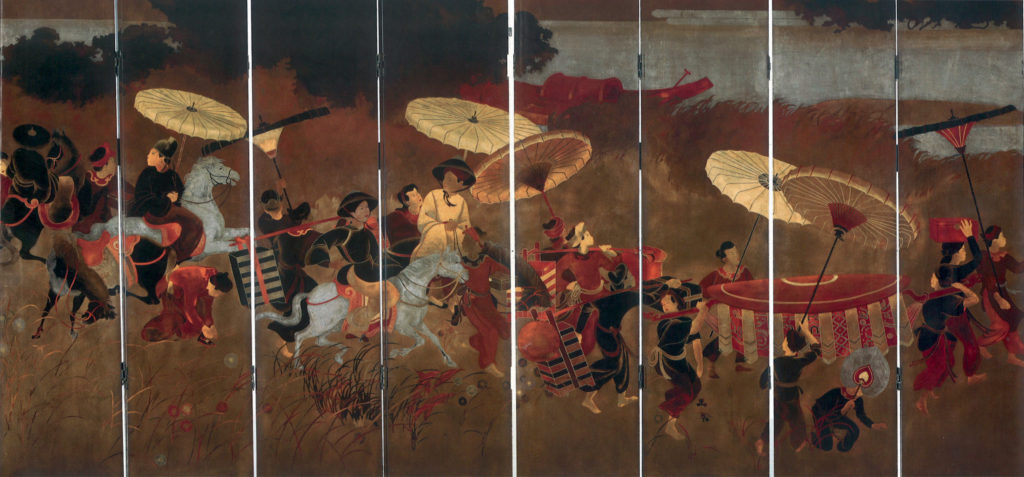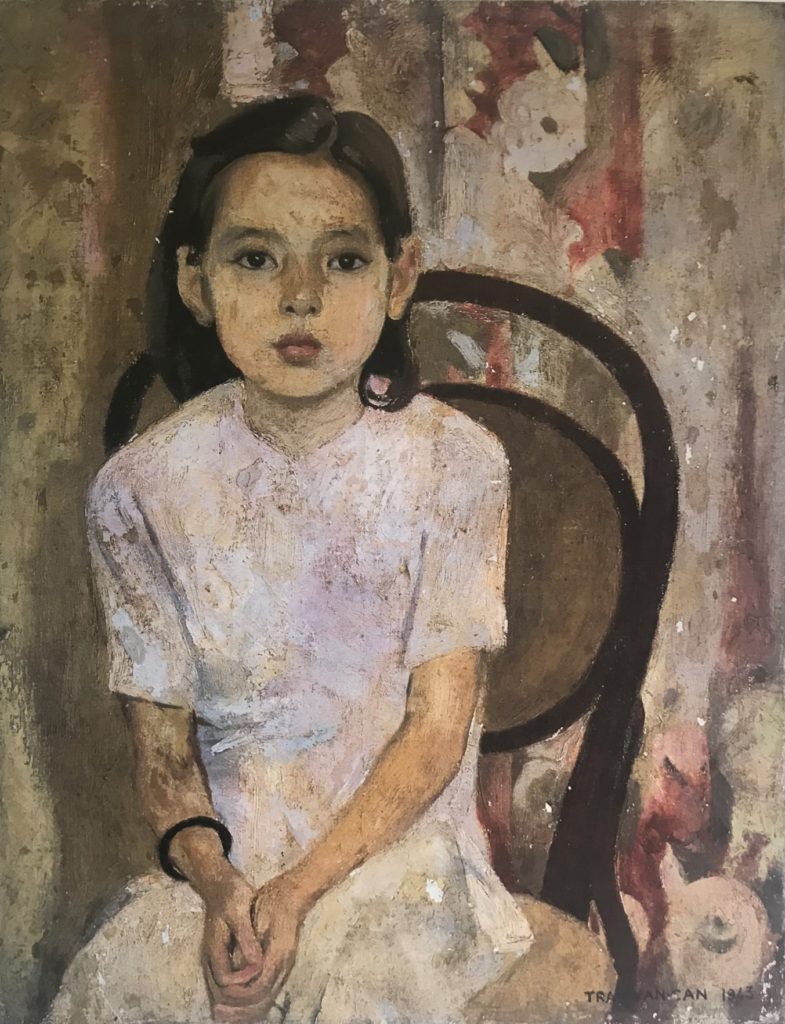The Bride’s arrival with her procession – Tran Van Can & Nguyen Khang

This majestic folding screen (122,5 x 240 cm) created with superb craftsmanship, is a fundamental piece of 20th century Vietnamese art. Signed by both Tran Van Can and Nguyen Khang, it is also situated at Atelier de laque de l’École Supérieure des Beaux-Arts (Lacquer workshop of the School of Fine Arts) and dated 1936 in Chinese – the screen gives us precious information about the development of lacquer work in Vietnam during that period.
The double signature, along with an additional seal by Tran Van Can, suggests that the lacquer was conceptualized and drawn by Tran Van Can but executed by Nguyen Khang, two processes that are associated – if not overlapping. The seal’s presence also indicates that the former was more highly regarded than the latter.

Top right, the date: “Mid-summer, 1936”.
In the middle: “Lacquer workshop of the Higher School of Fine Arts”.
Below: the “Beaux-Arts” seal.
Left: Inscription “Painted by Tran Van Can” with a “Tran Van Can” seal.
Still on the back of the screen is written in Chinese: “Nguyen Khang”.
The identity-identification chosen by the two protagonists (even if the inscriptions are on the back…) in this year 1936, is not a signature or indication in romanized letters. An unusual choice compared to most artists who would use these immediately after leaving school or in conjunction with the Chinese writing. Here the ideogram is exclusive. Nothing is readable for those who do not read Chinese characters. The addition of the seal amplifies the identification.
Beyond the signature this work seems to be purely Vietnamese (a lacquer executed in Hanoi). But is it really? The theme could be Chinese: the (future) bride, her procession of porters, the horses and parasols, the sampans in the distance, including the comical horse obviously angry on the far left, everything could be Chinese. A question worth asking considering that the artists, for the graphics, chose not to follow the École des Beaux-Arts, a School highly regarded that proved, during the Paris Colonial Exhibition (1931), the existence of an autonomous Vietnamese painting. Paintings that are unique to Vietnam by its subject and the mastery of lacquer technic.
The year 1936 is, also true in Vietnam, is the year of all dangers: art without conscience is also the ruin of the soul.
Technically, the double signature (only Tran Van Can’s has a seal as well) indicates that the conception is Tran Van Can’s responsibility and the execution is Nguyen Khang’s and that the presence of a seal also means more honor for the first artist than the second. Such is the agreement between the two friends who met at the Hanoi School of Fine Arts – both received majors in the entrance examination, respectively in 1936 and 1935 – as they both know that in lacquer, the design and the craftsmanship are both part of the creative process and are not separate.
As we have seen: artistic lacquer in Vietnam is a French import, a French import magnified by a local tradition. This local tradition is more about the material it is about its artistic use. The imported French influence (Inguimberty must have known the works of Jean Dunand in the 1920s), the subtlety of the students (Le Pho, Tran Quan Tran…), the technical contribution of Dinh Van Thanh, the enthusiasm of Alix Aymé have created a solid foundation, which Nguyen Gia Tri will testify, for example.
Under the patronage of Dinh Van Thanh, the two established artists embarked on a mission to refine lacquer-making technique. Tran Van Can sanded the cinnabar, thereby laying the cornerstone of the « lacquer-edifice » and became one of the pioneers of lacquer painting.

Seven years later, in 1943, Tran Van Can completed an oil painting of his niece that is now considered one of the most celebrated treasures of the Fine Arts Museum of Hanoi, Little Thuy, the present Lot seems to be a logical progression in the artist’s repertoire. Little Thuy was considered an innovative feat as it united the country’s political undertones with the touching sincerity of a bright-faced innocent girl, illustrated with Western features and clothing. In the same innovative spirit, Tran Van Can applied Western laws of space and perspective relating to composition, shape and figures into lacquer painting.
This masterpiece by Tran Van Can paradoxically shows us a return to a purely French tradition, which confirms that an artist’s choices are never final.
But let us return to our screen where light and vitality are bursting with a great feeling of open space. « L’Arrivée de la Mariée avec Son Cortège » depicts the bridal entourage – consisting of four horses and twenty-two figures, excluding the young bride who is hidden under the veiled hammock – marching forward while bearing seven parasols, which are symbols of a mandarin’s power. The scene implies that the marriage unites two important families. The artists also included popular imageries denoting colors of the nuptial march such as gold, silver, and vermilion, as well as the « beetle wing » pattern.
This poetic and lyrical scene was executed with precision and close attention to detail, from the luxurious bridal hammock canopy and the figures’ billowing clothes to the dynamic, bustling procession, hinting at the hurried commotion and anticipation of the bride’s journey.
In contrast, motionless rowboats in the distant background are reminders that as time goes by it will accomplish what it must and that the immediacy in Mother, I wish to marry:
« Mother, don’t you see our neighbor of the east welcoming his bride and our neighbor of the North leading his daughter to her new home, from East to West, what commotion ».
Jean-François Hubert